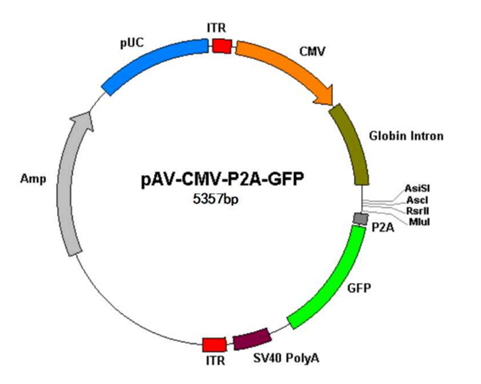Cre-loxP Recombination System
one. Principle of operation of Cre-loxP recombination system
1. Cre recombinase and loxP sites
Creclase Recombination Enzyme is encoded by the Cre gene of E. coli phage P1 and is a 38 kD protein consisting of 343 amino acids. It is not only catalytically active, but also similar to restriction enzymes, capable of specifically recognizing loxP sites.
The loxP (locus of X-overP1) site is 34 bp long and includes two 13 bp inverted repeats and an 8 bp spacer region. Among them, the inverted repeat sequence is a specific recognition site of Cre recombinase, and the spacer region determines the direction of the loxP site.

Figure 1. Cre recombinase and loxP sites
(http://2012.igem.org/Team:Tsinghua-A/Project/Design)
2. Cre-loxP recombination system induces genetic recombination
     Â
The Cre-loxP system has several ways to induce recombination based on the interaction of Cre recombinase with the loxP site.
When there is a loxP site in the genome, once there is a Cre recombinase, it will bind to the inverted repeat region at both ends of the loxP site to form a dimer. This dimer binds to dimers of other loxP sites, which in turn form tetramers. Subsequently, the DNA between the loxP sites was cleaved by Cre recombinase, and the nick was religated under the action of DNA ligase. The result of the recombination depends on the position and orientation of the loxP site. There are several main ways to reorganize:
(1) The two loxP sites are located on the same DNA strand in the same direction, and the Cre recombinase knocks out the sequence between loxP;
(2) The two loxP sites are located on the same DNA strand and in opposite directions, and Cre recombinase induces sequence turnover between loxP;
(3) Two loxP sites are located on different DNA strands or chromosomes, and Cre recombinase induces exchange or chromosomal translocation of two DNA strands;
(4) Four loxP sites are located on two DNA strands or chromosomes, and Cre recombinase induces sequence exchange between loxP.

Figure 2. Ways of Cre-loxP-induced gene recombination
(https://)
two. Advantages of the Cre-loxP reorganization system
 Â
The reason why the Cre-loxP recombination system is widely used in transgenic animals is that it has obvious advantages. Mainly reflected in: time and space specific, efficient, accurate, rapid.

Figure 3. Advantages of the Cre-loxP reorganization system
three. Application of Cre-loxP Recombination System in Transgenic
 Â
   Â
Due to the efficient and simple action mode of Cre-loxP recombination system, it has been effectively utilized in gene site deletion, site-specific integration of foreign genes, establishment of disease animal models, screening of highly expressed loci, etc., and has become a powerful DNA recombination in vitro and in vivo. tool.

Figure 4. Application of Cre-loxP recombination system in transgenes
four. Advantages of virus-dependent genetic recombination
   A more common form of application of the Cre-loxP recombination system is the hybridization of two transgenic animals. The general strategy is:
    (1) Transgenic "Cre mice" were obtained by pronuclear injection. The expression of Cre recombinase in this mouse is typically controlled using a specific promoter;
(2) introducing a selectable marker gene into the target site in embryonic stem cells by homologous recombination of the replacement vector, and introducing two loxP sites on both sides, requiring both homologous chromosomes to have a loxP site. It does not interfere with the transcription of the target gene. The embryonic stem cells are injected into the pseudo-pregnant mother to develop into "floxed mice";
(3) "Cre mice" mate with "floxed mice", and in the resulting offspring, Cre recombinase interacts with the loxP site, resulting in gene recombination.
Although this method has an efficient and specific reorganization of the Cre-loxP recombination system, there are many shortcomings:

At present, because virus-dependent gene recombination can overcome many shortcomings of transgenic animals, it has become a new choice for more and more researchers. The strategy of the virus-dependent Cre-loxP recombination system is:
    (1) Obtaining a "Cre mouse" or "floxed mouse" by means of a transgenic animal;
(2) The virus is injected with this "Cre mouse" or "floxed mouse" to introduce a loxP or Cre recombinase element.
    The advantages of this method are obvious:

Fives. ViGene provides you with AAV vector construction and virus packaging services for the Cre-loxP recombination system
1. FLEX-ON system that relies on Cre recombinase to induce expression
   Â
Combined with tissue-specific promoters and different AAV serotypes, ViGene's FLEX-ON system can help you achieve more precise tissue-specific control and time control.
In the FLEX-ON system, the target gene is located in the opposite direction of the promoter, and two "head-to-head" loxPs are connected on both sides. When the Cre recombinase is absent, the target gene cannot be expressed; when the Cre recombinase is present, the target gene can be induced to "flip" and express.

Figure 5. ViGene provides Cre-dependent FLEX-ON system diagram (top) ViGene's FLEX-ON experiment diagram (bottom)
2. Relying on the Cre recombinase trans-splicing system - easy to have "AAV expressing large genes"
Smaller packaging capabilities (less than 5 kb) limit AAV applications. ViGene offers Cre-dependent trans-splicing systems that make it easy to have AAVs that express large genes.
The co-transfection efficiency of multiple recombinant AAVs was as high as 90%, and ViGene divided the larger genes into two parts and constructed them on two AAV vectors. The expression of the target protein is achieved by ITR recombination, mRNA splicing and Cre-loxP to eliminate the inhibition of transcription by ITR. The expression efficiency of the Cre-dependent trans-splicing system provided by the single vector ViGene is about 20%.

Figure 7. Schematic diagram of ViGene's Cre-dependent trans-splicing system (left) ViGene's Cre-dependent trans-splicing system experiment (right)
China Extract Powder For Use As Dietary Supplement Extract Powder, Extract Powder Manufacturer
Shaanxi Kang New Pharmaceutical co., Ltd. , https://www.bodybuildingoil.com